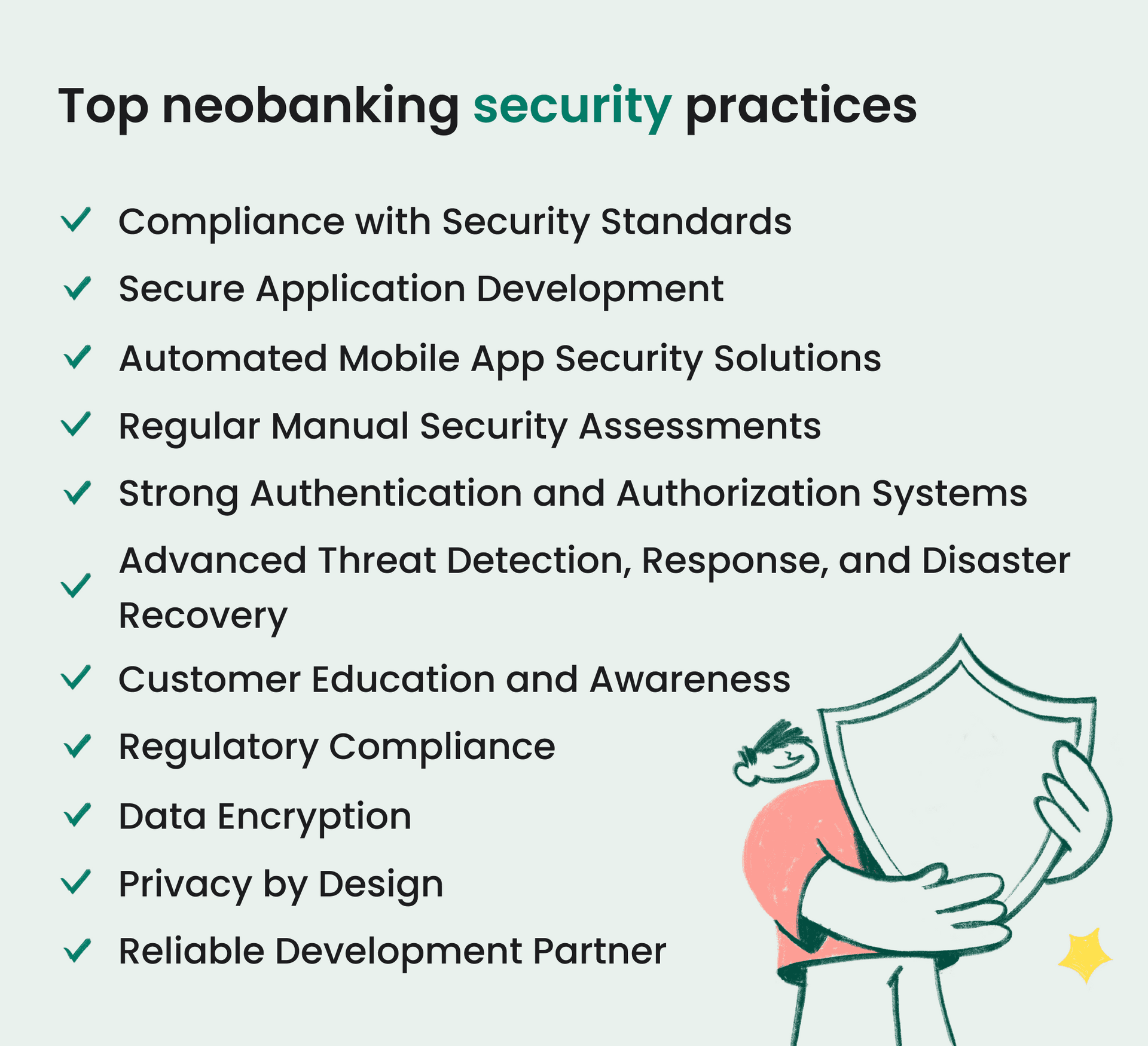The neobanking market is growing at a rapid pace; the estimation of its worth by 2032 is around $3.3 trillion, according to experts. Neobank services are the modern alternative to long and bureaucratic banking operations, which are the best choice for young and innovative customers. Along with these advantages at breakneck speed, we have some cybersecurity risks. A neobank is liable to face data breaches, phishing attacks as well as sophisticated fraud attempts. This necessitates an impactful risk-reduction process, which is crucial to obtain the confidence of the stakeholders and guarantee the survival of these financial entities. Being the backbone of e-banking information security systems, robust measures against cyber threats are essential, and all the stakeholders have to understand cyber risks and develop strategies to tackle them. Agilie aims to describe the best security practices that neobanks should take into account.
-
According to the forecast, by 2032, the neobanking market will have a value of $3.3 trillion, bearing witness to its significant impact on the global financial area.
-
Neobanks must have high data security and privacy to safeguard sensitive data and gain customer trust.
-
The constant improvement and the setting up of solid alliances should help the neobanks stay afloat and reliable, although the threats are becoming more complex.
Neobanking Threat Landscape
Unlike traditional banks, which use physical servers, cloud-based banking systems can pose a more significant threat to cyberattacks because of the vulnerabilities from a security perspective. Neobanks face sophisticated cyber threats such as:
-
Malware
-
Ransomware
-
Spoofing
-
Phishing
-
API vulnerabilities
-
Third-party dependency
-
Data privacy issues
To resist these risks, the neobanks require strong security measures, diligent regulatory policies, and a prevention approach to new vulnerabilities.
Top Security Practices for Neobanking
Neobanks must adopt robust security measures to protect sensitive data and maintain user trust as the financial industry transitions towards a digital-first approach.

1. Compliance with Security Standards
For neobanks, adherence to established security standards is not just a regulatory requirement but a foundational element of customer trust and operational integrity. These standards ensure that the bank`s technology builds a security protocol of high standards to avoid data breaches and cyber threats. Agilie has high-security principles and offers a flexible framework that is specifically for mobile banking apps within fintech companies.
2. Secure Application Development
Neobanks consider secure application development as one of the most significant steps to embed security throughout the lifecycle of digital products.
Integrating Security from the Start: The principle of "security by design" focuses on ensuring that developers build security into the software development process right from the beginning, making it an integral part of the application development process. Developers who receive training in secure coding should be aware of common security issues in application development, such as injection flaws, broken authentication, sensitive data exposure, and cross-site scripting (XSS). They should also utilize frameworks like OWASP Top 10 to manage risks.
Incorporating DevSecOps: A DevSecOps system that combines speed and efficiency with security measures by implementing security tests into CI/CD pipelines. With this collaboration, there is quick detection and resolution of vulnerabilities, as the pace of development does not suffer.
Update and Patch Management: Secure development entails attentive updates and patch management for fixing vulnerabilities using automation tools that track dependencies and enforce timely updates to safeguard applications from emerging threats.
 Learn more about our secure mobile software development services.
Learn more about our secure mobile software development services.
3. Automated Mobile App Security Solutions
Utilizing automated security solutions is crucial in identifying and mitigating vulnerabilities efficiently. Tools like Appknox offer Static Application Security Testing (SAST), Dynamic Application Security Testing (DAST), and API testing, which together provide a thorough analysis of the mobile banking app both in the pre-production and post-production stages. SAST helps identify issues in source code before the app is run, whereas DAST simulates attacks on a running application to find runtime vulnerabilities. API testing ensures that the interfaces between applications are secure from potential exploits.
4. Regular Manual Security Assessments
Although automated tools are efficient for continuous testing, manual security assessment is the preeminent approach, revealing the complexity of vulnerabilities and business logic errors the computerized tools may not discover. Security experts who develop tactics like complex attack scenarios achieve security auditing through careful examinations to point out weaknesses and security loopholes. Apart from reinforcing the security posture, such processes align with compliance requirements that often insist on extensive audits.
5. Develop Strong Authentication and Authorization Systems
Providing robust authentication and authorization mechanisms is a key to account and sensitive transaction security in neobanking.
Multi-Factor Authentication (MFA): Implement MFA for customers and staff so they do not rely only on username and password.
Biometric Authentication: Leverage biometric authentication techniques, including fingerprint scans, retinal scans, and facial recognition, to amp up security for accessing the app.
Role-Based Access Control (RBAC): Define roles and permissions clearly to ensure users have access to the data and only to the actions that are acceptable for their role.
 Learn more about neobanking development process in our article.
Learn more about neobanking development process in our article.
6. Data Encryption
The implementation of data encryption ensures that neobanks preserve the security of critical information and establish a safe environment for financial and customer information storage and transfer.
Significance and Types of Encryption
At-Rest Encryption: Protects data stored on disks and other media from being compromised even when the attacker can reach the storage devices physically.
In-Transit Encryption: Protects data as it flies over networks, mainly using TLS (Transport Layer Security), to keep the data from being intercepted in the middle of its journey.
End-to-End Encryption (E2EE): Makes sure the data is encrypted from the sender's device and only decrypted by the receiver's device; hence, data safety is ensured.

7. Advanced Threat Detection, Response, and Disaster Recovery
Highly developed threat detection systems rely on machine learning, behavior analytics, and heuristic analysis to detect malicious activities in a bank's digital environment. A security incident response plan is needed to reduce the chances of security breaches. Containment, eradication, and recovery are the critical activities of security incident response plans. After any security issues, a well-thought disaster recovery plan is required to get the IT services and processes working again.
SIEM and SOC: Develop a Security Information and Event Management (SIEM) System and Security Operations Center (SOC) to assist in round-the-clock monitoring and immediately interpret security alerts.
Anomaly Detection: AI and machine help in behavioral analysis and anomaly detection that can detect suspicious activities promptly.
Incident Response Plan (IRP): Write, implement, and monitor an IRP to respond swiftly to the security breach.
Disaster Recovery (DR): Establish the DR program, which will encompass scheduling backups and restoring services and data in case of a catastrophe.
8. Privacy by Design
Privacy by Design is a fundamental principle for neobanks, which means embedding privacy rights into any tech or operation in the neobank. This proactive approach fosters trust with customers and maintains the highest international standards.
The Main Points in Privacy by Design:
-
Minimize Data Collection: Collect the strictly required data for the intended purposes only.
-
Secure Data by Default: Instantly safeguard individual information without user engagement.
-
Full Functionality: Disregard privacy for functionality; constantly endeavor to maintain both.
-
End-to-End Security: Be sure that data from collection to destruction is safe.
-
Transparency and Visibility: Adhere to open approaches and transparent processes that explain how data will be managed.
-
User Privacy Empowerment: Give users simple and convenient privacy settings with clear notifications concerning their rights.
 Find out how to hire a reliable development team to build a neobank.
Find out how to hire a reliable development team to build a neobank.
9. Regulatory Compliance
Neobanks need to be technically compliant and follow regulations and laws, as it is also necessary to keep their business operations legitimate and earn customers' trust. Key compliance areas include:
-
Anti-money laundering (AML).
-
Combating the financing of terrorism (CFT).
-
Data protection (like GDPR).
-
Consumer protection.
-
Payment services regulations.
Effective compliance programs include continuous training, monitoring, and regulatory mechanisms. As for neobanks, regulatory compliance should be viewed as a strategic tool by which sustainable business development and operational reliability of the company can be achieved.
10. Customer Education and Awareness
Customer education and awareness are essential components of neobank security strategy, which involves improving security by giving customers the knowledge to recognize threats and respond to them appropriately. Educated customers act as the first defense against fraud and cyberattacks.
Key Areas of Focus
-
Phishing Awareness: Train customers to distinguish between legitimate and malicious emails and links.
-
Secure Transactions: Provide instruction on safe online banking practices and network security.
-
Password Management: Educate about the use of strong passwords and frequent updates.
-
Utilizing Security Features: Encourage using built-in security features like biometrics and fraud alerts.
Neobanks can achieve effective customer education through the following:
-
Regular Security Updates: Use emails, mobile apps, and social media to teach security skills.
-
Interactive Tools: Create quizzes and simulations so customers can interact interestingly with security training.
-
Responsive Customer Support: Provide the support staff with training to handle security questions and offer preventive advice.
Educating clients, in addition to reducing the cyberattack risk, creates a trusting atmosphere.
11. Choosing a Reliable Development Partner
The choice of a development partner is a critical factor that highly affects the security and operation reliability of the neobanking platforms. A trustworthy partner in technology development will know the latest technologies and security practices, ensuring conformance with international standards and compliance.
Agilie is a trusted partner in fintech that offers expertise in developing neobank, and adheres to international security standards.
 Are you looking for top-notch neobank development services? Learn more about our expertise.
Are you looking for top-notch neobank development services? Learn more about our expertise.
Conclusion
The neobanking market pace is growing by technological progress and the desire to digitalize financial solutions. The key to building cyberinfrastructure is a strong security culture that includes fast threat detection, 24/7 monitoring, and quick incident response strategies. Active engagement in the development strategies and implementation thereof that will keep pace with the technological advancement and innovative ways of cybercriminals in penetrating systems will be required constantly.
Agilie team has 14 years of experience in the fintech industry. We provide innovative solutions, helping neobanks safeguard their operations, and ensure the trust of their customers.
 Contact Agilie and let our specialists help develop your secure neobanking future.
Contact Agilie and let our specialists help develop your secure neobanking future.
